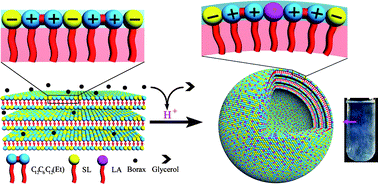Phase and self-assembly transition induced by glycerol–borax interaction in an aqueous surfactant two-phase system†
Abstract
We report that the phase and

* Corresponding authors
a
Beijing National Laboratory for Molecular Science (State Key Laboratory for Structural Chemistry of Unstable and Stable Species), College of Chemistry and Molecular Engineering, Peking University, Beijing, People's Republic of China
E-mail:
yunyan@pku.edu.cn, jbhuang@pku.edu.cn
Fax: +86-10-62751708
Tel: +86-10-62765058
b University of Bayreuth, BZKG, Bayreuth, Germany
We report that the phase and

 Please wait while we load your content...
Something went wrong. Try again?
Please wait while we load your content...
Something went wrong. Try again?
Y. Zhao, Y. Yan, L. Jiang, J. Huang and H. Hoffmann, Soft Matter, 2009, 5, 4250 DOI: 10.1039/B911564A
To request permission to reproduce material from this article, please go to the Copyright Clearance Center request page.
If you are an author contributing to an RSC publication, you do not need to request permission provided correct acknowledgement is given.
If you are the author of this article, you do not need to request permission to reproduce figures and diagrams provided correct acknowledgement is given. If you want to reproduce the whole article in a third-party publication (excluding your thesis/dissertation for which permission is not required) please go to the Copyright Clearance Center request page.
Read more about how to correctly acknowledge RSC content.
 Fetching data from CrossRef.
Fetching data from CrossRef.
This may take some time to load.
Loading related content
